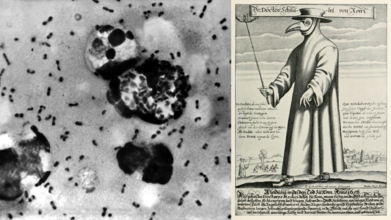- Health Conditions A-Z
- Health & Wellness
- Nutrition
- Fitness
- Health News
- Ayurveda
- Videos
- Medicine A-Z
- Parenting
Bubonic Plague California Resident: Here's All That You Need To Know About The Disease

Credits: Canva and Wikimedia Commons
Bubonic Plague: A Lak Tahoe area resident has tested positive for plague, as confirmed by the California health officials on Tuesday. The officials have confirmed that the resident was infected after being bitten by an infected flea while camping in the South Lake Tahoe area.
What does this mean for people living in the surround area? Questions about plague, how is it spread, or is it preventable are of course spiraling in everyone's mind right now.
Here, we try to answer all your concerns.
California Resident Plague Case 2025
What happened? The health officials in California confirmed that a South Lake Tahoe resident tested positive for the plague. This is the same centuries-old disease that had killed millions during the Black Death.
The individual is believed to have contracted the infection after being bitten by an infected flea while camping near the Lake Tahoe Basin. According to El Dorado County Public Health, the patient is receiving care and recovering at home.
“Plague is naturally present in many parts of California, including higher-elevation areas of El Dorado County,” said Kyle Fliflet, the county’s acting public health director. “It’s important that individuals take precautions for themselves and their pets when outdoors, especially while walking, hiking and camping in areas where wild rodents are present.”
Also Read: What History Teaches Us About Plague? Are There More Than One Type?
Plague: It is an illness that you can get from the bacterium Yersinia pestis or the Y pestis. It is a zoonotic disease, which means you can get it from animals and they also can get it from you. The disease usually spreads through bites from fleas that have been infected by biting an infected animal.
Read: California Resident Tests Positive For Plague, Officials Trace Case Back To Lake Tahoe Flea
Is The Bubonic Plague Back?
The Global Center for Health Security, by the University of Nebraska Medical Center notes that the bubonic plague never really went away.
The bubonic plague wiped out tens of millions of people in Europe in the 14th century and it thus gained the label 'Black Death'.
Last year too, a rare case of human plague was confirmed in rural Oregon, as confirmed by the Deschutes County Health Services. As per the report the individual is said to be infected by a pet car, which had symptoms.
As per the Centers for Disease Control and Prevention (CDC), US, on an average, seven human plague cases are reported each year in the country.
Is Bubonic Plague Contagious?
As per the World Health Organization (WHO), while not totally eradicated, "human to human transmission of bubonic plague is rare". However, bubonic plague is contagious.
The CDC notes that people usually get plague after being bitten by an infected rodent flea or by handling an infected animal. People can also become infected through exposure to sick pets, especially cats, which had been the case from Oregon, last year.
There are 3 ways a plague can spread, through animals, through blood, and through infectious droplets. However, all three different ways make for three different kinds of plagues. For bubonic plague, it is spread by flea bites, notes CDC.
Flea bites: Infected fleas transmit plague after feeding on sick rodents. When rodents die, fleas look for new hosts, including humans and pets, potentially causing bubonic or septicemic plague.
Contaminated fluids/tissues: Handling infected animals, such as skinning animals without protection, can spread plague bacteria, usually leading to bubonic or septicemic plague.
Infectious droplets: Plague pneumonia in humans or animals can release bacteria into the air. Inhaling these droplets may cause pneumonic plague, though direct close contact is usually required. Cats are especially vulnerable and can pass the infection to people.
Bubonic Plague Symptoms
The common signs of bubonic plague are:
- Fever
- Headache
- Chills
- Weakness
- One or more swollen, painful lymph nodes, called buboes (where the disease derives its name from)
These symptoms of bubonic plague usually start within the period of 2 to 8 days after being bitten.
The bacteria multiply in a lymph node near where the bacteria entered the human body. If the patient is not treated with the appropriate antibiotics, the bacteria can spread to other parts of the body.
Bubonic Plague Mortality Rate
As per EBSCO, a platform that provides research databases, e-journals and other library resources, the bubonic plague has a historically high case fatality ratio from about 30 to 60%. However, today, with the help of treatment, it can be reduced to 5% to 15%.
The CDC notes that over 80% of the US plague cases have been in bubonic form, with seven cases each year. Plague has occurred in people across all ages, though 50% of cases happen in people aged 12 to 45. CDC notes that while it happens to both men and women, the plague is more common in men, probably "because of increased outdoor activities that put them at higher risk".
Does Drinking Cold Water Help With High Blood Pressure? Expert Reveals

Credits: Canva
Consuming enough water each day plays an important role in keeping the body working as it should. It helps digestion and metabolism, supports temperature control, aids waste removal, and keeps organs and tissues in good condition. Still, whenever blood pressure rises, many people look for quick fixes, and one of the most common questions is whether drinking cold water can calm the numbers.
The idea sounds straightforward, but the body reacts to cold in more layered ways. Knowing how cold water influences the heart and blood vessels can help separate fact from assumption. To understand this better, we spoke with Dr Rajeev Chowdry, Director of Internal Medicine at Yatharth Super Speciality Hospital, Sector 20, Faridabad.
Can Cold Water Help With Blood Pressure?
Cold water may bring down blood pressure for a brief period. Drinking chilled water can activate the vagus nerve in some individuals, which slows the heart rate and leads to a short-lived drop in blood pressure. The body also triggers a “diving reflex” when exposed to cold, such as splashing cold water on the face, and this can cause a similar short-term response.
Dr Rajeev explained, “Cold water may lower blood pressure for a small amount of time, but not enough to replace someone’s prescribed treatment for hypertension or to be trusted as a method to manage the condition.” He added that for certain people, cold exposure might have the opposite effect, causing blood vessels to tighten and raising blood pressure instead.
Blood Pressure: Who Is Most At Risk?
According to Dr Rajeev, some groups are more vulnerable to a rise in blood pressure, added strain on the heart, or other problems linked to sudden cold exposure:
- High Blood Pressure (Hypertension) — Cold temperatures narrow blood vessels, which can push blood pressure even higher and raise the risk of stroke or heart attack.
- Older Adults — With age, arteries become less flexible, making it harder for the body to adjust to sudden changes in temperature.
- People With Heart-related Health Issues — Cold exposure can place extra demand on the heart by raising blood pressure, changing heart rate in some cases, and reducing blood flow to the heart as blood vessels tighten. This may trigger chest pain for some individuals.
- Patients With Arrhythmias — Those with irregular heart rhythms may experience worsening symptoms, particularly with sudden contact with cold water.
- Individuals On BP-lowering Medication — Some may feel dizzy, lightheaded, or rarely faint if very cold conditions combine with medication that lowers blood pressure.
In summary, while water alone will not manage high blood pressure, staying well hydrated supports overall health and may contribute to better long-term blood pressure control. Anyone making changes to their routine should check with a healthcare professional, especially those already dealing with medical conditions or concerns about their blood pressure.
Is Your Skin Reacting to Toxic Air? Dermatologists Point to 8 Early Warning Signs

Credits: Canva
Air pollution is now recognised as a major trigger for skin problems. Dust, smoke residues, PM2.5 particles, and heavy metals settle on the skin through the day. They weaken the barrier, disturb the skin’s balance, and speed up signs of ageing. People living in crowded, high-traffic areas often notice dullness, pigmentation, breakouts, and sensitivity more than those in cleaner environments.
Two skin specialists helped us understand the early warning signs you should never overlook.
8 Signs Your Skin Is Reacting to Pollution
1. Sudden Dullness and Loss of Glow
Pollutants oxidise the skin’s natural lipids and damage its protective layer. This makes the face look tired and lifeless even when sleep and nutrition are well balanced. Many people notice a loss of glow on days spent outdoors, especially during peak pollution periods., as per Dr Geeta Grewal, Cosmetologist and Founder of 9Muses Wellness Clinic
2. More Blackheads and Clogged Pores
Dr Grewal notes that PM2.5 particles slip into pores and mix with sweat and sebum. This leads to blackheads, whiteheads, and congested skin. A rough, bumpy texture is one of the most common pollution-related concerns.
3. Frequent Breakouts
Rising pollution levels increase inflammation and oxidative stress, which disrupts the skin’s microbiome. These changes can bring tiny breakouts, fungal acne-like clusters, or painful pimples. Environmental irritants often act as hidden triggers, especially in urban areas.
4. Uneven Skin Tone and Pigmentation
Constant oxidative stress encourages the skin to produce more melanin. According to Dr Grewal, this results in dark spots, sun spots appearing sooner, and patchy pigmentation along the cheeks, nose, and forehead. Many people mistake this for sun damage alone, but pollution plays a major role.
5. Increased Sensitivity
If skincare products that once felt comfortable now sting or cause redness, pollution may be weakening your skin barrier. Warning signs include burning, itching, a warm sensation on the skin, or sudden irritation without a clear cause, as per Dr Ameesha Mahajan, Cosmetic Dermatologist and Founder, Eden Skin Clinic.
6. Early Fine Lines and Premature Ageing
Dr Mahajan explains that pollutants trigger free radical damage. This breaks down collagen and elastin, the proteins that keep skin firm and smooth. Over time, it leads to wrinkles, crow’s feet, and mild sagging around the eyes and mouth.
7. Dry, Rough, or Dehydrated Skin
Pollutants strip moisture and damage the barrier, causing tightness and flakiness even in people with oily skin. When the barrier is compromised, moisturisers stop working as well, which worsens dehydration.
8. Frequent Rashes or Dermatitis Flares
People with sensitive skin conditions such as eczema, psoriasis, or rosacea may notice more flare-ups when pollution rises. Dr Mahajan says that constant exposure can lead to rashes, bumps, and patchy irritation that keeps returning.
Avoiding pollution entirely is difficult, but protecting your skin is possible. Strengthen the barrier with antioxidants, sunscreen, gentle cleansers, and weekly detox habits. Watch for the early warning signs mentioned by the experts and act early. A strong skin barrier remains the most reliable way to maintain clear, healthy, and youthful skin despite rising pollution levels.
Silent Varicocele: The Hidden Male Infertility Threat India Is Ignoring—Here’s How Surgery Can Help

Credits: Canva
Male infertility remains a topic rarely discussed, often overshadowed by social pressures and hesitation. Yet, it contributes to nearly half of all cases where couples struggle to conceive. Among the many causes, varicocele stands out as one of the most silent and underrecognised conditions, affecting a significant number of men in India.
With male reproductive health still a taboo, countless men remain unaware of their condition for years. Fertility tests often reveal the issue only after prolonged delays, adding emotional stress for couples. We got in touch with Dr. Suparna Bhattacharya, Fertility Specialist, Nova IVF Fertility, Kolkata, who told us more about the same.
What Is a Varicocele?
A varicocele occurs when the veins in the scrotum become enlarged, similar to varicose veins in the legs. These weakened, dilated veins disrupt blood flow to the testicles, causing a gradual rise in temperature that negatively affects sperm production and quality. Most men experience no pain, which is why the condition is often undetected, earning it the label of a “silent” problem. In many cases, it is discovered only during routine infertility evaluations.
Why It’s a Common Yet Ignored Cause of Male Infertility
Varicocele is particularly concerning because it often goes untreated, leading to more serious reproductive consequences. Dr. Suparna Bhattacharya said, “The condition may not produce noticeable symptoms—no pain, no swelling—yet internally, impaired blood flow and heat buildup gradually reduce sperm count, motility, and quality. Research shows varicocele accounts for a large proportion of male infertility cases, and the condition is largely reversible if identified early.”
A lack of awareness, coupled with the common misconception that infertility is primarily a female issue, often delays evaluation of the male partner. Many men only undergo semen analysis or scrotal ultrasound after significant time has passed.
Can Surgery Restore Fertility?
The encouraging news is that varicocele is one of the few male infertility issues that can be effectively treated with surgery. Varicocelectomy, the most common procedure, involves tying off the affected veins while preserving normal blood flow. This helps cool the scrotum and allows sperm production to return to healthier levels.
Dr. Suparna Bhattacharya told us that post-surgery, many men experience notable improvements in sperm count and motility within six months. For couples, this can mean natural conception without advanced fertility treatments. Correcting varicocele can also improve sperm DNA integrity, enhancing the success rates of procedures like IVF or ICSI.
Potential Consequences of Untreated Varicocele
Not all varicoceles require surgery, especially if mild or asymptomatic. However, undetected or significant varicoceles can progressively impair sperm quality and, in some cases, lead to testicular atrophy. Delayed diagnosis can reduce the likelihood of natural conception as men age.
When Should You See a Doctor?
Men who have been trying to conceive for over a year should undergo a comprehensive fertility check-up. A simple semen analysis and physical examination are often sufficient to detect most varicoceles. “Early intervention is crucial, particularly for those hoping for natural conception or planning to start a family,” said Dr. Suparna Bhattacharya
Promoting awareness about male reproductive health is just as important as educating women on fertility. Varicocele is a silent, yet easily treatable, condition. Timely diagnosis and treatment can restore fertility and reduce the emotional and financial strain on couples. The first step toward healthier, happier families is acknowledging the issue, seeking treatment, and discussing it openly.
© 2024 Bennett, Coleman & Company Limited

